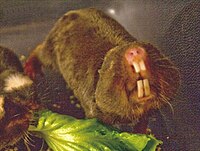
Photo from wikipedia
Seismic signalling in the form of hind foot drumming plays an integral role in the communication of several species of African mole‐rats (Bathyergidae). To produce these vibrational signals, alternating hind… Click to show full abstract
Seismic signalling in the form of hind foot drumming plays an integral role in the communication of several species of African mole‐rats (Bathyergidae). To produce these vibrational signals, alternating hind limbs strike the ground repetitively at high speeds by flexion and extension of the hip and knee. This descriptive study aimed to determine whether anatomical differences in hind limb osteology and/or musculature between drumming and non‐drumming species of three Bathyergidae species could be detected. Formalin‐fixed left and right hind limbs of 24 animals (N = 48) consisting of three species (n = 16 each) of two drumming species, Georychus capensis and Bathyergus suillus, and one non‐drumming species, Cryptomys hottentotus natalensis, were dissected to determine the origins and insertions of individual muscles. After dissection, all soft tissue was removed by maceration. Hind limb bones, including the pelvis, were photographed, and the exact muscle origin and insertion points were electronically mapped onto the images using imaging software. On lateral view, the acetabular position was parallel to the sacrum in G. capensis, while being more ventral in position in the other two species. The shape of the femur head was spherical and the neck defined in all species. The distal shaft of the femur was gracile and the epicondyles were robust and prominent in the non‐drumming C. h. natalensis compared with the drumming species. Shallow and relatively wide patellar grooves were observed in all three species. In the two drumming species, m. gracilis was single, whereas it was double in C. h. natalensis. In all three species, m. tensor fasciae latae was absent. The more dorsal positioning of the acetabulum in G. capensis may be needed to increase the stability of the spine and allow for more force to be exerted on the pelvis during drumming. It is unlikely that m. gracilis plays a role in drumming, as the singularity or doubling thereof is variable among rodents. It is additionally postulated that m. gluteus superficialis has taken the hip rotator role of m. tensor fasciae latae as it partially inserted onto the lateral fascia of the thigh. The more robust ilia, femoral shafts and tibiae observed in the two drumming species studied here are possible adaptations for hind foot drumming, as robust bones are able to withstand the additional biomechanical loading during drumming.
Journal Title: Journal of Anatomy
Year Published: 2019
Link to full text (if available)
Share on Social Media: Sign Up to like & get
recommendations!